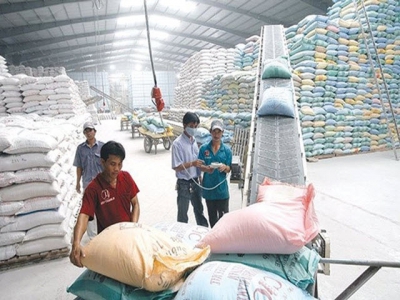Vietnam reconsidering rice production, export plans

Vietnam’s rice export turnover has been increasing year after year, but most exports continue to be raw and pre-processed products, experts say.
Vietnam is one of the top three rice exporters
According to the Ministry of Agriculture and Rural Development (MARD), Vietnam is one of the top three rice exporters of the world with average export volume of 5-7 million tons a year and export turnover of $2.5-3.5 billion in 2011-2017.
The average export price in the first 10 months of 2018 was $504 per ton, an increase of 12.3 percent over the same period of 2017.
Vietnam’s rice has stable export markets. Asian markets consume 70 percent of total exports. Of these, China is the biggest client with 35 percent, followed by the Philippines, Indonesia and Malaysia.
African countries imported 28 percent of Vietnam’s exports in 2013. However, exports to the markets have decreased sharply because of white rice from India and Thailand which have competitive prices.
In the US market, Vietnam is the third biggest exporter. Oceania is a new client of Vietnam, but this is a promising market with consumption amounting to 7 percent of exports in 2017.
However, MARD pointed out that the output of Vietnam’s rice remains unstable and the risk from price fluctuation exists.
The Prime Minister has decided that Vietnam needs to reduce the export volume before raising export prices.
In the 2017-2020 period, Vietnam plans to export 4.5-5 million tons of rice products a year, with average value of $2.2-2.3 billion. The figures are 4 million tons and $2.3-2.5 billion, respectively, for 2021-2030.
To reach this goal, low- and medium-grade rice exports must not be higher than 20 percent of total exports.
Meanwhile, high-quality white rice exports need to account for 25 percent, while the proportion should be 30 percent for fragrant, specialty and japonica rice, and 20 percent for sticky rice. The remaining will be high added-value rice products, such as nutritious rice, parboiling and organic rice.
It is expected that by 2030, low-quality rice exports would not be higher than 10 percent of total exports.
The acting head of the HCMC Institute for Development Studies, Tran Anh Tuan, noted that if the Mekong Delta, the country’s rice granary, continues to develop rice production and export in width, it will earn more money by expanding production and will fall into the ‘unsustainable development’ trap.
Meanwhile, Nguyen Duc Thanh, head of VEPR (Vietnam Institute for Economic and Policy Research), believes that the successful building of Vietnamese rice brand will lay a firm foundation to increase exports.
Có thể bạn quan tâm
 Vietnam's rice exporters face a tough year
Vietnam's rice exporters face a tough year Rice being harvested in Vi Thuy District, Hau Giang Provinve. Prime Minister Nguyen Xuan Phuc has asked for rice to be stockpiled to cope with falling prices.
 Vietnamese mango finds 40th export market – the US
Vietnamese mango finds 40th export market – the US After 10 years of persistent negotiations, Vietnam has conquered one of the most fastidious markets to export mango, the US.
 Star apple shipment to US to increase threefolds
Star apple shipment to US to increase threefolds The Mekong Delta province of Tien Giang aims to ship 300 tonnes of star apples to the United States until the end of the 2018-2019 crop